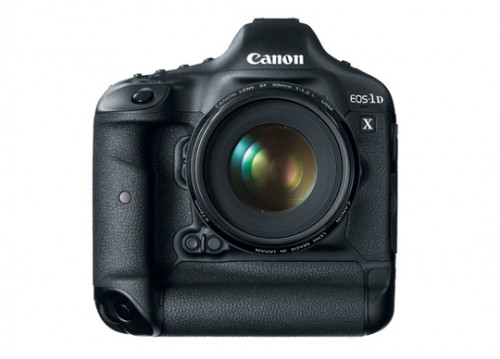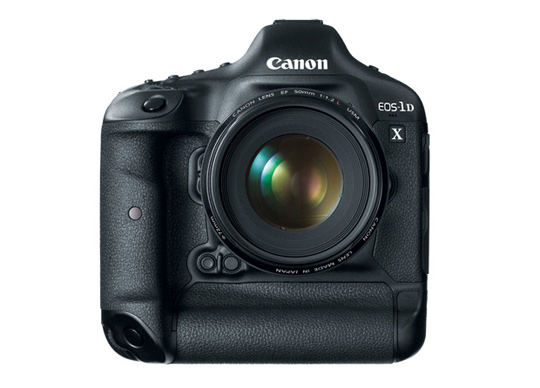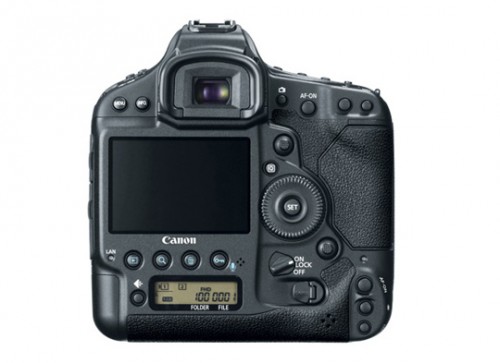
Specifications
Type
Digital, AF/AE single-lens reflex camera
Recording Media
- Dual CF Cards (Type I or II)
- Compatible with UDMA 7 CF cards
Image Format
Approx. 36 mm x 24mm (35 mm Full-frame)
Compatible Lenses
Canon EF Lenses
Lens Mount
Canon EF mount
Image Sensor
Type
High-sensitivity, high-resolution, large single-plate CMOS sensor
Pixels
Effective pixels: Approx. 18.1 megapixels
Total Pixels
19.3 megapixels
Aspect Ratio
3:2 (Horizontal:Vertical)
Color Filter System
RGB primary color filters
Low Pass Filter
Fixed position in front of the image sensor
Dust Deletion Feature
(1) Self Cleaning Sensor Unit
- Carrier wave type
- Removes dust adhering to the infrared- and ultraviolet-blocking glass.
- Self-cleaning executed automatically (taking about 1.8 sec.) when power is turned on or off. Manual execution also possible (taking about 5.2 sec.).
- Low-pass filter has a fluorine coating.
(2) Dust Delete Data acquisition and appending
- The coordinates of the dust adhering to the infrared- and ultraviolet-blocking glass are detected by a test shot and appended to subsequent images.
- The dust coordinate data appended to the image is used by the provided software to automatically erase the dust spots.
Dimensions and Weight
Dimensions (W x H x D)
Approx. 6.2 x 6.4 x 3.3 in. (158 x 163.6 x 82.7 mm)
Weight
TBA
The Ultimate EOS.
Canon has brought the best of the EOS-1D Series of digital cameras into one phenomenal model: the new flagship of the EOS line, the EOS-1D X*. Its full-frame 18.1 Megapixel CMOS sensor and all-new Dual DIGIC 5+ Image Processors deliver high quality image capture at up to 12 fps (14 fps in Super High Speed Mode) and a powerful ISO range of 100 – 51200 (up to 204800 in H2 mode) provides sharp, low-noise images even in the dimmest low-light conditions. An all-new, 61-Point High-Density Reticular AF and 100,000-pixel RGB Metering Sensor that uses a dedicated DIGIC 4 Image Processor, makes the EOS-1D X reach new levels of focus speed and accuracy delivering advanced tracking even for the most challenging shooting situations. Taken all together, the EOS-1D X’s improved HD video capture, numerous connectivity options, combination of processing power and durable construction, including shutter durability tested to 400,000 cycles, make it the ultimate EOS.
Features
- Newly designed 18.1 Megapixel full-frame CMOS sensor, 14-bit A/D conversion, wide range ISO setting 100-51,200 (L:50, H1: 102400, H2: 204800) for shooting from bright to dim light and next generation Dual DIGIC 5+ Image Processors for enhanced noise reduction and blazing processing speed.
- New 61-Point High Density Reticular AF including 41 cross-type AF points with f/4.0 lens support including 5 dual diagonal AF points (sensitive to f/2.8), plus EOS iTR (Intelligent Tracking and Recognition) AF for accurate subject tracking.
- EOS iSA (Intelligent Subject Analysis) powered by Canon’s DIGIC 4 Image Processor, featuring a 100,000-pixel RGB Metering Sensor with subject and color recognition for reliable AE.
- EOS HD Video with manual exposure control and multiple frame rates (1080: 30p (29.97) /24p (23.976) / 25p, 720: 60p (59.94) / 50p, 480: 60p (59.94) / 50p) with 4GB automatic file partitioning (continuous recording time 29 minutes 59 seconds) with selectable “All i-frame” or IPB compression.
- Outstanding shooting performance: up to 12.0 fps continuous shooting (14.0 fps in Super High Speed Mode) using a UDMA CF card.
- Magnesium alloy body with shutter durability tested up to 400,000 cycles, exclusive dust-and-weather resistance, and new Ultrasonic Wave Motion Cleaning (UWMC) for improved vibration-based dust removal.
- Intelligent Viewfinder with superimposed LCD display, approximately 100% field of view, wide viewing angle of 35 degrees, and 0.76x magnification.
- 3.2-inch Clear View II LCD monitor, 170 degree viewing angle, 1,040,000-dot VGA, reflection resistance with multi coating and high-transparency materials for bright and clear viewing.
- Improved handling with the addition of new customizable controls, and enhanced recording options with Dual Card Slots, Gigabit-Ethernet terminal, and compatibility with optional Canon Wireless File Transmitter and GPS Receiver.
- Additional Features.
Brilliant Sensor, Supercharged Processors.
18.1 Megapixel full-frame CMOS sensor
The EOS-1D X features a newly developed Canon full-frame 18.1 Megapixel CMOS sensor that’s designed from the ground up to create high resolution, perfectly detailed images with unprecedented speed and clarity. A full 24 x 36mm, the sensor captures 5184 x 3456 large individual 6.95 µm pixels and has a much-improved S/N ratio resulting in better images from the start. A new photodiode structure with an increased photoelectric conversion rate increases the sensor’s sensitivity by approximately 2 stops over previous models, meaning higher ISOs with the lowest noise of any EOS digital camera. And a 2-line 16-channel simultaneous signal readout means speeds of up to 12 fps (RAW + JPEG) and even 14 fps (Super High Speed Mode) are possible!
14-bit A/D conversion, wide range ISO setting 100-51200 (L: 50, H1: 102400, H2: 204800)
The EOS-1D X not only offers 14-bit signal processing for excellent image gradation, it delivers higher standard and expanded ISOs, and a score of new options to enhance shooting in varied and fast-changing lighting situations. With a standard range of ISO 100-51200, the EOS-1D X represents a 2-stop increase in sensitivity over previous cameras. Thanks to the improved signal-to-noise ratio of the new sensor and powerful noise reduction, the EOS-1D X can shoot at expanded sensitivities down to ISO 50 (L) and up to 102400 (H1), and even 204800 (H2)! Beyond the obvious advantages of its wide ISO range, the EOS-1D X has automatic ISO settings, found on the dedicated ISO menu. Minimum and maximum ISO settings can be specified, as can a user-defined range, plus full auto and manual.
Dual DIGIC 5+ Image Processors for enhanced noise reduction and blazing processing speed
For a whole new level of performance, the EOS-1D X uses Dual DIGIC 5+ Image Processors that include four 4-channel A/D converter front-end processing circuits and deliver speeds of up to 12 fps (RAW + JPEG) and 14 fps (JPEG). Compared with the predecessor, Canon’s DIGIC 4 Image Processor, the Dual DIGIC 5+ Image Processor offers approximately 17x faster processing speed, and feature new algorithms that promote greater noise reduction at higher ISOs. In addition to conventional image processing functions the Dual DIGIC 5+ Image Processors offer real-time compensation for Chromatic Aberration in both still and motion images. With the power of these two processors, speed improvements are noticeable from the instant the camera is turned on and the stunning results speak for themselves.
Canon’s Most Sophisticated AF, Period.
All new 61-Point High Density Reticular AF
The newly designed 61-Point High Density Reticular AF features an Offset Array Sensor (with staggering AF point arrangement) to deliver greater accuracy, no matter the situation. It offers multi-zone wide-area AF for better tracking, has 5 central dual cross-type points (f/2.8 diagonal), 21 central cross-type points (f/5.6 horizontal & vertical) and 20 outer cross-type points (f/4.0 horizontal), and is sensitive in extremely low-light situations (EV-2 for a central point with a f/2.8 lens).
The EOS-1D X has a dedicated AF menu tab, so AF can be controlled without having to go through custom function menus. It also has 6 AF point selection methods (Spot, Single Point, Single + Adjacent 4 Points, Single + Adjacent 8 Points, Zone Selection, and Automatic AF Point Selection), plus a dedicated AF configuration tool for control of AI Servo AF III tracking parameters (tracking sensitivity, acceleration/deceleration tracking, and AF point auto switching).
The EOS-1D X uses the 100,000-pixel RGB Metering Sensor to aid the AF system in Automatic Point Selection. This dramatically increases the tracking performance for subjects that were previously unpredictable to follow, such as fast-moving or flying subjects. EOS iTR (Intelligent Tracking and Recognition) AF recognizes the subject based on face and color detection from the AE system, and tracks it using AF points. The EOS iSA (Intelligent Subject Analysis) System incorporates color recognition and Face Detection for proper exposure. Specific parameters can be adjusted and refined and saved in the AF menu for later use.
Intelligent Exposure, Fast.
EOS iSA (Intelligent Subject Analysis System) Powered by Canon DIGIC 4 Image Processor
The EOS-1D X features a brand new 100,000-pixel RGB Metering Sensor with a dedicated DIGIC 4 Image Processor that delivers substantial improvements in evaluative ambient and flash metering. The sensor has 252 distinct zones for general metering, with 35 zones used for low-light metering. The meter’s DIGIC 4 Image Processor uses EOS iSA (Intelligent Subject Analysis System) that incorporates face and color recognition data for more stable performance under rapidly changing lighting situations. The E-TTL Flash metering gains the same improvements. These improvements ensure accurate automatic exposure in a greatly increased group of shooting situations, offering a level of performance that will impress even the seasoned pro.
Sophisticated HD Recording at the Touch of a Button.
EOS HD Video Recording
Addressing the requests of the pros, the EOS-1D X captures HD video with an unprecedented level of sophistication for a digital SLR. It offers both All-I and IPB compression, supports H.264/MPEG-4 AVC High Profile, and automatically splits files greater than 4GB (FAT specifications) for extended recording up to 29:59 minutes without interruption. It offers the option of timecoding only during recording (Rec Run) or at all times (Free Run) – useful for multi-camera shoots. The EOS-1D X offers easy operation with the new Live View shooting/Movie shooting button. Menu options can still be set even when the Live View image is displayed. A dedicated menu tab for video capture allows functions to be changed quickly on the fly. Improved sound recording adjustment capabilities offer 64-step volume control; and a sound recording level meter that is accessible through the Quick Control screen during video shooting. With the Silent Control function, adjustments can be made quietly with a touch pad located on the inner portion of the Quick Control Dial. The built-in wind filter helps suppress unwanted wind noise that can distort or muffle sound. The CMOS sensor’s new drive system significantly increases image processor performance, reducing color artifacts and moiré.
| AII-I | Compresses each frame. Although the file size is larger than IPB, each frame is not affected by the previous and next frames, making it suitable for editing and extracting frames. |
| IPB | Compresses the movie frame by referencing the previous and next frames. High compression is used, making it suitable for recording long movies. |
Incredibly Fast Image Capture.
High-Speed Continuous Shooting
The EOS-1D X combines fast 16-channel data readout from its 18.1 Megapixel CMOS sensor and the supercharged processing capabilities of its Dual DIGIC 5+ Image Processors with a speedier shutter and mirror system to raise the performance bar for all digital cameras, capturing full-frame images and recording them fast to UDMA cards stored in the cameras Dual Card Slots. Ideal for fixed focus situations, the EOS-1D X’s can shoot up to 12 fps (RAW + JPEG). In Super High Speed Mode, high-speed shooting up to 14 fps (JPEG) is possible.
Thanks to a more resilient design, shutter lag with the EOS-1D X is reduced to 55ms (down even further to 36ms via custom function). A redesigned mirror system, featuring a Quad Active Mirror Stopper, uses more effective material to absorb impact when moving up and down not only aids in speedy shot-to-shot times, but the reduced mirror vibration provides more stable shots at all times.



0 Comments